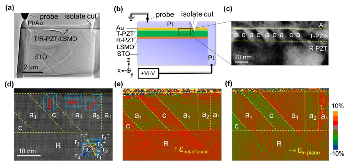Deterministic Ferroelastic Domain Switching Using Ferroelectric Bilayers
Abstract
Composition gradients, or dissimilar ferroelectric bilayers, demonstrate colossal electromechanical figures of merit attributed to the motion of ferroelastic domain walls. Yet, mechanistic understanding of polarization switching pathways that drive ferroelastic switching in these systems remains elusive. Here, the crucial roles of strain and electrostatic boundary conditions in ferroelectric bilayer systems are revealed, which underpin their ferroelastic switching dynamics. Using in situ electrical biasing in the transmission electron microscope (TEM), the motion of ferroelastic domain walls is investigated in a tetragonal (T) Pb(Zr,Ti)O3 (PZT)/rhombohedral (R) PZT epitaxial bilayer system. Atomic resolution electron microscopy, in tandem with phase field simulations, indicates that ferroelastic switching is triggered by predominant nucleation at the triple domain junctions located at the interface between the T/R layers. Furthermore, this interfacial nucleation leads to systematic reversable reorientation of ferroelastic domain walls. Finally, deterministic ferroelastic domain switching, driven by the interfacial strain and electrostatic boundary conditions in the ferroelectric bilayer, provides a viable pathway toward novel design of miniaturized energy-efficient electromechanical devices.
- Authors:
-
- Brookhaven National Lab. (BNL), Upton, NY (United States). Condensed Matter Physics and Materials Science Dept.; Univ. of New South Wales, Sydney, NSW (Australia). School of Materials Science and Engineering
- Brookhaven National Lab. (BNL), Upton, NY (United States). Condensed Matter Physics and Materials Science Dept.
- Pennsylvania State Univ., University Park, PA (United States). Dept. of Materials Science and Engineering
- Univ. of New South Wales, Sydney, NSW (Australia). School of Materials Science and Engineering
- Publication Date:
- Research Org.:
- Brookhaven National Lab. (BNL), Upton, NY (United States)
- Sponsoring Org.:
- USDOE Office of Science (SC), Basic Energy Sciences (BES)
- OSTI Identifier:
- 1566820
- Report Number(s):
- BNL-212108-2019-JAAM
Journal ID: ISSN 1530-6984
- Grant/Contract Number:
- SC0012704
- Resource Type:
- Accepted Manuscript
- Journal Name:
- Nano Letters
- Additional Journal Information:
- Journal Volume: 19; Journal Issue: 8; Journal ID: ISSN 1530-6984
- Publisher:
- American Chemical Society
- Country of Publication:
- United States
- Language:
- English
- Subject:
- 75 CONDENSED MATTER PHYSICS, SUPERCONDUCTIVITY AND SUPERFLUIDITY; ferroelectric bilayer; ferroelastic switching; domain wall reorientation; in-situ TEM
Citation Formats
Zhang, Yangyang, Han, Myung-Geun, Garlow, Joseph A., Tan, Yueze, Xue, Fei, Chen, Long-Qing, Munroe, Paul, Valanoor, Nagarajan, and Zhu, Yimei. Deterministic Ferroelastic Domain Switching Using Ferroelectric Bilayers. United States: N. p., 2019.
Web. doi:10.1021/acs.nanolett.9b01782.
Zhang, Yangyang, Han, Myung-Geun, Garlow, Joseph A., Tan, Yueze, Xue, Fei, Chen, Long-Qing, Munroe, Paul, Valanoor, Nagarajan, & Zhu, Yimei. Deterministic Ferroelastic Domain Switching Using Ferroelectric Bilayers. United States. https://doi.org/10.1021/acs.nanolett.9b01782
Zhang, Yangyang, Han, Myung-Geun, Garlow, Joseph A., Tan, Yueze, Xue, Fei, Chen, Long-Qing, Munroe, Paul, Valanoor, Nagarajan, and Zhu, Yimei. Wed .
"Deterministic Ferroelastic Domain Switching Using Ferroelectric Bilayers". United States. https://doi.org/10.1021/acs.nanolett.9b01782. https://www.osti.gov/servlets/purl/1566820.
@article{osti_1566820,
title = {Deterministic Ferroelastic Domain Switching Using Ferroelectric Bilayers},
author = {Zhang, Yangyang and Han, Myung-Geun and Garlow, Joseph A. and Tan, Yueze and Xue, Fei and Chen, Long-Qing and Munroe, Paul and Valanoor, Nagarajan and Zhu, Yimei},
abstractNote = {Composition gradients, or dissimilar ferroelectric bilayers, demonstrate colossal electromechanical figures of merit attributed to the motion of ferroelastic domain walls. Yet, mechanistic understanding of polarization switching pathways that drive ferroelastic switching in these systems remains elusive. Here, the crucial roles of strain and electrostatic boundary conditions in ferroelectric bilayer systems are revealed, which underpin their ferroelastic switching dynamics. Using in situ electrical biasing in the transmission electron microscope (TEM), the motion of ferroelastic domain walls is investigated in a tetragonal (T) Pb(Zr,Ti)O3 (PZT)/rhombohedral (R) PZT epitaxial bilayer system. Atomic resolution electron microscopy, in tandem with phase field simulations, indicates that ferroelastic switching is triggered by predominant nucleation at the triple domain junctions located at the interface between the T/R layers. Furthermore, this interfacial nucleation leads to systematic reversable reorientation of ferroelastic domain walls. Finally, deterministic ferroelastic domain switching, driven by the interfacial strain and electrostatic boundary conditions in the ferroelectric bilayer, provides a viable pathway toward novel design of miniaturized energy-efficient electromechanical devices.},
doi = {10.1021/acs.nanolett.9b01782},
journal = {Nano Letters},
number = 8,
volume = 19,
place = {United States},
year = {Wed Jul 03 00:00:00 EDT 2019},
month = {Wed Jul 03 00:00:00 EDT 2019}
}
Web of Science
Figures / Tables:
 Figure 1: (a) A low magnification TEM image of the cross-sectional sample with the tungsten tip brought into contact with Pt layer. (b) Schematic of the experimental set up for in situ TEM under external bias, where LSMO is used as the bottom electrode on the STO substrate while goldmore »
Figure 1: (a) A low magnification TEM image of the cross-sectional sample with the tungsten tip brought into contact with Pt layer. (b) Schematic of the experimental set up for in situ TEM under external bias, where LSMO is used as the bottom electrode on the STO substrate while goldmore »
Figures / Tables found in this record:

 Search WorldCat to find libraries that may hold this journal
Search WorldCat to find libraries that may hold this journal